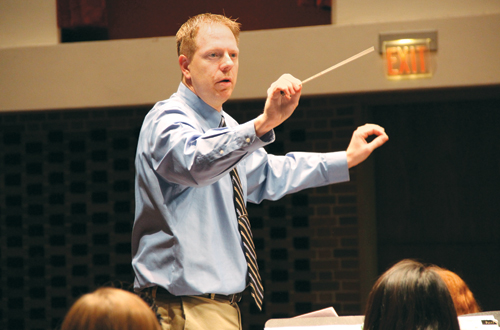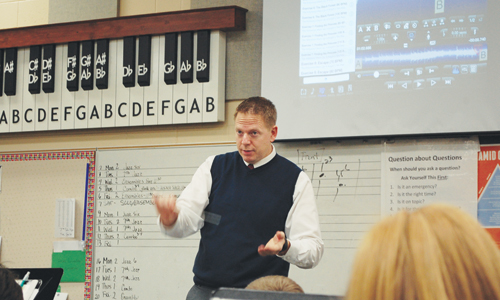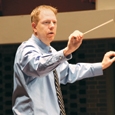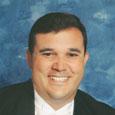
While the state of Wisconsin may need a few months to thaw out from its traditional winters, Chris Gleason is keeping things hot in his part of the state. From unique ways to stimulating middle school students’ interest and creativity to giving major composers like Brian Balmages and John Mackey an idea or two for a new band commission, there is something special going on at Patrick Marsh Middle School in Sun Prairie.
When did you know you wanted to teach music?
I probably knew by middle school, when I was about 10 or 11 years old. My father was a band director, so I grew up in his band room. My brother is also a band director, so it was a rite of passage.
How did you get started at Patrick Marsh Middle School?
I started here 12 years ago. My wife grew up in Sun Prairie, a suburb outside Madison. Sun Prairie has always had a reputation as having a wonderful music program. When we started dating in college, her little brother was in the high school jazz ensemble, which won an audition to play at the Essentially Ellington competition with Wynton Marsalis. The band placed third, and as they were on stage with Wynton, I remember thinking, “These are high school students?” They sounded amazing. When there was an opening in Sun Prairie, it seemed like an obvious choice. I have great colleagues here.
Once students are in your program, what are the biggest challenges in retaining them?
I have learned over the years that if you ignite students’ curiosity, passion, and joy, they will stay in your ensemble. I believe that students don’t stay in band just to improve on an instrument. Rather, they stay in band to make music, to learn about themselves, and to see the world through a different lens. Selecting high-quality literature is the first step in keeping students. The music is our curriculum, and it is what should nourish students’ souls and minds.
A recent example of a great piece we studied was Moscow 1941 by Brian Balmages. We explored the history behind the work and how the music effectively portrays the story. One of my assignments was to ask the students to take the idea of group identity and come up with a mission statement – a plan of attack for their cause. One group of students created what they called the Sit Down Club. This group of students found other students at school that would ordinarily sit by themselves at lunch and simply get to know them better. One day my principal noticed this interaction and asked me what was going on. My one-word reaction was, “Band.” He questioned that answer, and I explained the project and what this group of students chose to do. Needless to say, my principal had an appreciation for my students’ efforts and also developed a greater appreciation for our profession. As the band director, I noticed that the students appeared to connect with this work at a greater level than simply worrying about difficult passages and other technical details. It was a powerful strategy that gave each of my students more ownership in the process and a deeper understanding of the music.
In teaching beginning students, what are the biggest challenges you have faced and how have you overcome them?
The biggest challenge we face is time. Our building houses sixth and seventh grades, which is a bit unique. We start our beginners a few weeks before their 6th grade year and only have them for two years before they move on to our Upper Middle School. Our lesson program and rehearsal schedule is similar to many schools in our area. To increase time with the students I have tried to become more efficient and effective with my teaching. I am involved in a committee called Comprehensive Musicianship through Performance (CMP) in Wisconsin. The CMP Project began in Wisconsin nearly 40 years ago. There are now CMP committees in Iowa and Illinois as well. Developed by actual K-12 teachers, CMP is a planning process that helps teachers explore the best practices for teaching music. The training process helps music teachers clarify their priorities without losing the essence of their own approach. This training has helped me give more responsibility to students and to make the most out of the time I have with them.
What we have learned from 40 years of CMP is that great educators know how to select and analyze great music, set clear outcomes, create varied and rich strategies, and embed meaningful assessments in an effort to go beyond just the notes.
How do you get students to practice?
After much thought and study I have come to believe that we cannot make students do anything. It is true that we can coerce or manipulate them, but those gains are usually temporary and come at a cost. Students must choose to practice. I believe this choice is made when students see the relevance of practicing, have some autonomy, and see how it will lead to greater growth. I teach them about myelin, the insulation that wraps our nerve fibers and increases signal strength, speed, and accuracy. We learn that mistakes are biologically required in order to improve, and we attend to the mistakes, break passages into chunks, and repeat them slowly and correctly. Arming students with the knowledge of how to practice and the role myelin plays has been a game changer.
You have a number of well-known composers writing for your band. How have these experiences benefitted your program?
We have been fortunate to work with some wonderful composers, and the benefits have been amazing. The focus of the project is to create an opportunity for students to engage in the creative process with an outstanding composer and educator. Most people do not realize that the idea or concept for each commission has come from students. Each year students are asked to come up with a creative idea that might be the basis for a new work. The students write papers discussing the concept, why it would make a good piece, and what it sounds like in their mind. The students then develop short videos introducing their idea, which we send off to the composer. When the work is completed, it is shared with the students. It is an amazing moment for them to hear their ideas come to life. The students show so much pride and excitement. Their focus and determination to perform it well for the composer pushes them to new heights each year.
You have an upcoming composition being conceived with John Mackey. Describe the process for getting a work commissioned for your group.
We are so excited about working with John Mackey. This will be his first work for this age level. The process for commissioning a work begins with selecting a composer. Selecting great literature to perform with your ensemble is in a way like an audition for future composers. If a work makes it onto my program I usually consider that composer as a possibility for a future commission. However, with our approach to commissions, it is important that the composer communicates and works well with kids. Once the composer is selected the next step is to contact them to find out if and when they are available. Composers have different ways to establish their fees (by the minute of music or a basic fee per grade level). Find out what their fee is to write the piece and if they can and will come out for the premiere. If so, you will need to find out what their stipend is for time at your school. Travel, food, and other expenses also need to be considered. When a date of delivery is set, nearly all composers will send you a contract with all of the specifics listed above. Funding can be found through grants, fundraising, or a consortium of schools banding together to share the cost.
What are some strategies you employ during your warmup?
I like to use the warmup as an opportunity to not only get the ensemble ready physically but also mentally prepared to dive deeper into the music. I try to avoid reactive rehearsals that are driven solely by fixing problems. I plan carefully and thoughtfully to use that time to make connections, to ask questions, and to get students even more curious.
As an example, I will often write out the melody for the selections we will play and give it to them long before the music is ever handed out. This gives every instrument the opportunity to learn the melody and make a musical line. Along with addressing technical concerns, it provides me with the opportunity to ask questions about the nature of the music and what might come next.
Rather than listing my rehearsal order on the board by the titles of the pieces, I will use something else about the piece that forces the students to think a bit about what they already know about the music. This could be listing the pieces by the composer’s name, or form, key, or style period. It is often a quick assessment for me, too, of something I taught the previous day about the piece.
How did this creative approach to writing the rehearsal order develop?
When analyzing a piece of music, I take a sheet of paper and jot down everything: composer name and dates, who it was commissioned by, key signature, form, timbre, and texture. I have a list of all the elements. For rehearsal, rather than put up the title, I’ll put up “Bb major,” “uses a three-note motif,” “composer also wrote Ascend,” or “B theme begins at measure 33.” This gets students to analyze their music. The first time I do this each year it is a bit chaotic. However, it is fun watching them talk to each other as they figure it out. As the year progresses they look forward to this challenge and expect it.
I rehearse that way, too. I rarely say, “start at measure 25.” Instead, I’ll say, “start at the B theme.” This is one of my favorite things to do with an honor band. I’ll ask everyone who has the melody at measure 25 to play and then immediately start. Usually no one plays, which leads to some good discussion. It gets the point across that the students are expected to be more than robots who make sounds on an instrument. I want them to think about who has the melody and how their part fits into it. The aim is for students to be complete musicians.

What is a typical rehearsal like with your full bands?
As students enter the classroom they see the order of the rehearsal on a rotating PowerPoint show, which includes general announcements as well. The PowerPoint may include a question for them to ponder as they get their instruments out. Class begins with music. We quickly move on to our warmup with standard breathing exercises, long tones, flexibility, articulation, and chorales. However, the warmup is tailored each day to review past learning or to foreshadow upcoming concepts. Conse-quently, the warmup is a natural bridge into the music.
During the rehearsal of the music I also ask students to do quick self-reflections by showing me “fist to five fingers” (a rating of zero to five) for how well they performed a section or their comfort level with a tempo. Nearly every rehearsal also contains a skill or strategy designed to further our understanding of the work. The strategies could include anything from journal reflections to displaying tension and release with movement to creating a new rhythmic pattern on the SmartBoard. I strive to make my strategies rich and varied to help students with differing learning styles.
I also work hard to have a moment in each rehearsal where a thought-provoking question is asked that may lead to a deeper awareness or a new connection. The rehearsals typically end like they began – with us making music. I sometimes ask students to fill out exit cards that ask them to jot down a few things learned today or new questions created.
How much time do the exit cards take to fill out?
Not much at all. There are many different ways to quickly gauge what students have learned. I might have someone come up to the SmartBoard to make a list or do a matching exercise, but one of my favorites is to give students 3×5 notecards and ask them to create a goal, take a position on a topic and support it, or answer a poignant question. Recently we were playing Not Afraid to Dream by Brian Balmages. This piece, written in memory of a high school tuba player who passed away, has a tuba duet at the end. One day I asked the students what it might have been like to be at the premiere of that work, knowing that student wasn’t back in the tuba section. It doesn’t always have to be a question like this; “what key signatures did we play in today?” is perfectly acceptable, but this is a great way to get to know your students better.
What have been the most memorable responses to the exit cards?
The day after September 11, 2001, I asked students “why is music important today?” One student said, “Because this is what makes America strong. Music is more important than ever, as it unites us as a country.” The cards that day were very touching and I was impressed that students could see the significant role music plays in our lives.






